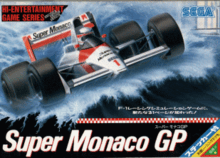Super Monaco GP
Super Monaco GP[lower-alpha 1] is a Formula One racing simulation video game released by Sega, originally as a Sega X Board arcade game in 1989, followed by ports for multiple video game consoles and home computers in the early 1990s. It is the sequel to the 1979 arcade game Monaco GP.
| Super Monaco GP | |
|---|---|
 | |
| Developer(s) | Sega |
| Publisher(s) | Sega |
| Series | Monaco GP |
| Platform(s) | Arcade, Sega Genesis, Amiga, Amstrad CPC, Atari ST, Commodore 64, Game Gear, Master System, ZX Spectrum |
| Release |
|
| Genre(s) | Racing |
| Mode(s) | Single-player |
| Arcade system | Sega X Board |
The arcade game consists mostly of one race: the Grand Prix of Monaco (though represented by a totally different track, albeit with the same features of the real-life Circuit de Monaco). The player chooses a transmission type before qualifying, and must complete the shortened track within 45 seconds to race; if they fail to do so, the game ends (in the home versions, if the player fails to qualify, they start the race in last position).
In the race itself, there is also a position limit, which starts on 20th (15th in the home versions) and decreases as the player bypasses checkpoints along the track, ultimately stopping on 3rd. If the player falls behind the indicated position and does not manage to recover fast enough or crashes, it is game over. The game was one of the first games to include a rear-view mirror along with Winning Run.
The Sega Genesis version of Super Monaco GP adds a World Championship mode. In the World Championship mode, the goal is to win a season of races, and then go on to defend the title. The circuits are modeled on the ones used in the 1989 Formula One season, with background scenery similar to the real-world circuit venues, though without the wealth of details the arcade version had. This version was also released in arcades for the Sega Mega-Tech system board in 1990.
Gameplay
The world championship mode starts with a relatively slow car in the Minarae. Drivers are able to name other drivers as rivals, and if a driver's rival defeats him in two consecutive races, the loser's team will offer a seat to the winner. Should the winner accept the seat, the loser will be fired from his team and take an open seat with another team which is usually ranked lower than the team the loser was fired from. This allows good drivers to get into teams with better cars, but also can punish drivers including the player for being poor drivers.
The goal is to win the F1 World Title by earning more driver's points than all other drivers. Once the player has won a season for the first time they are given the opportunity to join Madonna (the game's equivalent of McLaren), the game's best team. At the start of the title defense year, the player is then challenged by a new rival, Brazilian driver G. Ceara from Team Bullets (the game's equivalent of Arrows), who is seemingly impossible to beat in the first two races, with the ability to maintain pace with the Madonna car (despite Bullets being one of the weaker teams of the game), and building a comfortable lead at the player's least mistake. If the player loses the first two races of the defending season to Ceara, they are dropped by team Madonna and Ceara takes his spot, leading the player to the now-vacant seat in Bullets. The challenge is then to get back to the top and win the second season, or if G. Ceara is defeated, to retain the Championship in the Madonna car. Once two championship seasons are won, the player beats the game.
Reception
| Reception | ||||||||||||||||
|---|---|---|---|---|---|---|---|---|---|---|---|---|---|---|---|---|
| ||||||||||||||||
The arcade version was a critical and commercial success in Japanese arcades.[7] On Famicom Tsūshin's arcade earnings chart, it was number-two in August 1989, just below Namco's 3D polygon racing game Winning Run. In September 1989, Super Monaco GP became number-one, overtaking Winning Run.[8] Super Monaco GP remained number-one in October 1989, above Sega's arcade version of puzzle game Tetris at number-two.[9] In Europe, the arcade version of Super Monaco GP was highly acclaimed by reviewers.[2][6][10][1] It came second place on Computer and Video Games magazine's list of the top arcade games of 1989.[11]
The Genesis version was also highly acclaimed. On release, Famicom Tsūshin scored it a 34 out of 40.[4] It garnered an at-the-time unprecedented 10–10–9–9 rating from Electronic Gaming Monthly's Review Crew[3][12] and a 93% from Mean Machines.[13]
See also
References
- "Super Monaco Grand Prix arcade game review". Solvalou.com. Retrieved 2015-05-29.
- "Super Monaco Grand Prix arcade game review". Solvalou.com. Retrieved 2015-05-29.
- "Super Monaco GP for GEN – Super Monaco GP Genesis – Super Monaco GP GEN Game". Gamespot.com. Retrieved 2010-05-15.
- 30 Point Plus: スーパーモナコGP. Weekly Famicom Tsūshin. No.335. Pg.30. 12–19 May 1995.
- Lange, Chip (October 1990). "Sega ProView: Super Monaco G.P." (PDF). GamePro. pp. 76–77.
- "Super Monaco Grand Prix arcade game review". Solvalou.com. Retrieved 2015-05-29.
- "Game Machine's Best Hit Games 25 - アップライト, コックピット型TVゲーム機 (Upright/Cockpit Videos)". Game Machine (in Japanese). No. 360. Amusement Press. 15 July 1989. p. 33.
- Famicom Tsūshin, issue 19 (September 15, 1989)
- Famicom Tsūshin, issue 22 (October 27, 1989)
- https://archive.org/stream/cvg-magazine-098/CVG_098_Jan_1990#page/n7/mode/2up
- "EGM review archive. WARNING extremely loooong". actioncorp.net. 2002-10-23. Archived from the original on 2007-09-27. Retrieved 2010-05-15.
- "Super Monaco GP – Sega Megadrive – Mean Machines review". Meanmachinesmag.co.uk. Retrieved 2010-05-15.